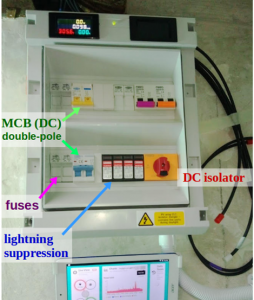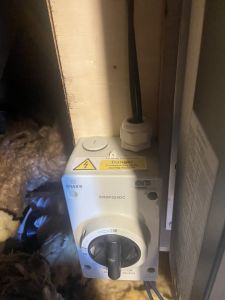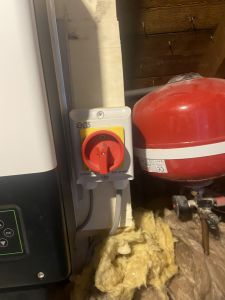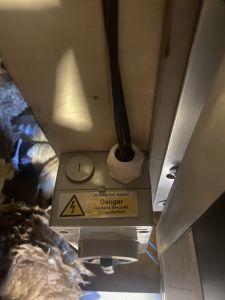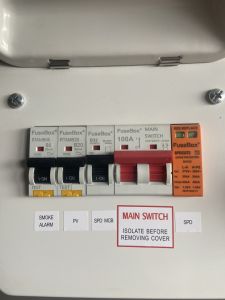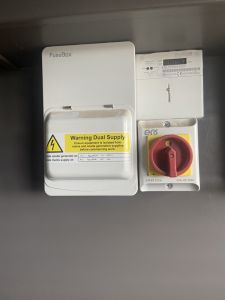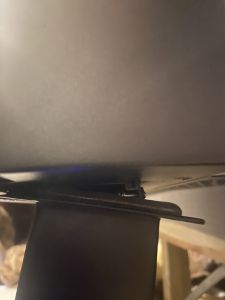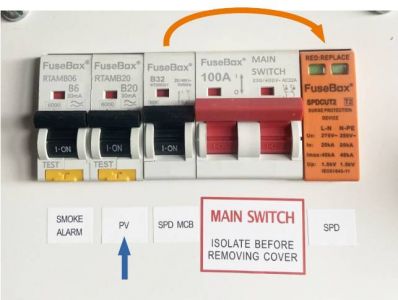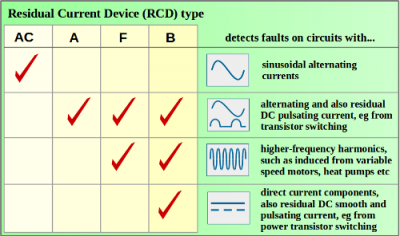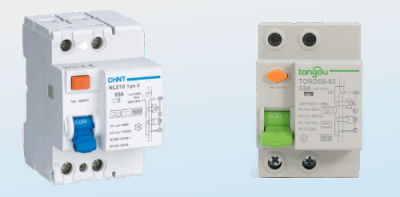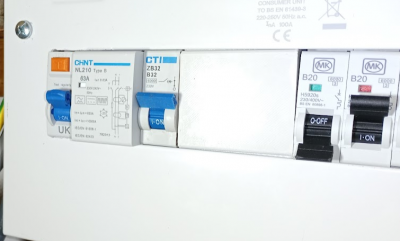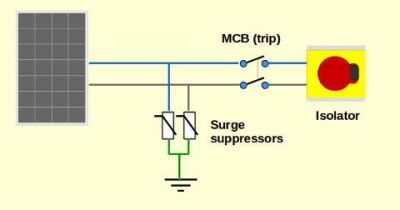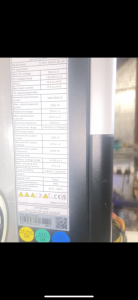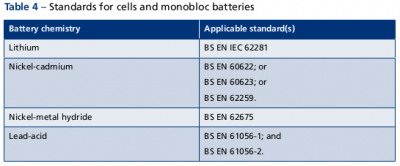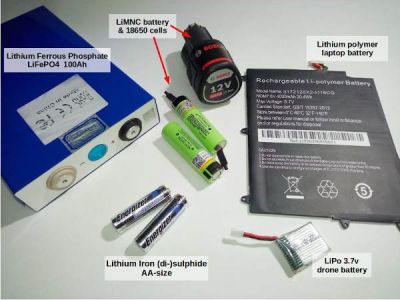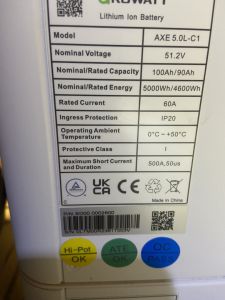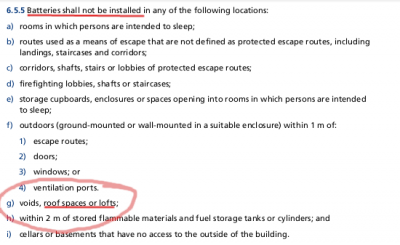Is this a bad installation and is there something wrong with my Samsung heat pump?
@transparent I’m still fighting with installers regarding an isolation for the batteries, my electrician noticed no breaker on the batteries and that the main consumer unit supplying power to solar has a type A fuse with a B curve and he said it should be a type B fuse. Installer refusing to comply.
Posted by: @david999the main consumer unit supplying power to solar has a type A fuse with a B curve and he said it should be a type B fuse.
I need some clarification... and a photo if you can manage it.
1: Did you mean to write 'supplying power to solar'?
Or did you mean 'supplying power to the inverter' (which also has solar input)?
2: Did you mean to write 'fuse', rather than MCB (Miniature Circuit Breaker)?
Fuses do have curves, which show the amount of excess current plotted against the time taken for the fuse to blow.
But when people mention a device in a consumer unit having a "B curve" then it's usually an MCB they're referring to.
There may also be fuses for the drop-wires from the solar panels to the inverter.
Moreover, those fuses might be housed in a box which looks like a consumer unit.
So there's plenty of room for confusion here!
However, the box (if present) which takes input from solar panels is usually called a String Combiner or Solar Combiner.
Here's one of my String Combiners:
Save energy... recycle electrons!
@transparent the panel cables go into an isolation on the side of inverter although you could get a bus through the gland, they are all like that and the black box bit isn’t screwed up to the inverter. There is an AC isolation on the right side and the consumer box with breakers downstairs. Fairly shoddy wiring if I’m honest.
Every time you post a photo I find something else to comment on !
I've put a blue arrow to show others the mains 'trip' we're discussing. (It's not a fuse).
It's an RCBO, which combines two functions in one unit:
- Over-current protection of 20A, which could otherwise be offered by an MCB. The B20 means that it uses the common B-curve for tripping speed.
- Earth-leakage protection of 30mA, to prevent fire or harm to a human who might inadvertently touch a live part. That could otherwise be offered by an RCD (residual current device)
RCDs are now categorised as follows:
If I understand correctly of what the two professional electricians have advised you, one is saying that it should be a Type B, capable of tripping out in the event of its mechanism detecting DC or pulsed DC components superimposed onto the 50Hz wave-form.
Type B units are rare, chunky and very expensive.
The usual price of the Chint one on the left of this photo is £250
A type-B rcd would normally only be required for a connection to an EV charger unit.
Even so, the majority of EV Charger Installers would only fit a Type-A RCD.
I have never yet met a Type-B RCBO, although they might exist.
For my EV charge-point I have a Type-B RCD, followed by a 32A MCB.
I have never heard of a device other than an EV charger requiring a Type-B earth-leakage trip.
It's extremely unlikely that you have a hybrid (mains & solar) inverter which needs this.
You will spot that I've also added an orange arrow to the photo you posted.
Your solar installer has fitted a Surge Protection Device rated to handle spikes (from lightning) up to 40,000 Amps.
But he's then connected that SPD to your house wiring via an MCB trip rated for only 32A 🤔
In the event of your solar panels being hit by lightning, the pulses will pass down the drop-cables to your inverter, which will suffer catastrophic failure because there's no lightning suppressor on those drop leads.
The lightning surge will then travel down the live, neutral & earth wires from the inverter to the consumer unit in your photo.
This is called a common-mode surge (equal across the conductors).
The SPD won't help because 40kA will destroy the relatively tiny wires which connect its 32A MCB in a large flash!
Lightning surge protectors must be directly wired to the copper busbars of the circuits they are there to protect.
They need short thick wires (typically 100mm long and 10mm² cross sectional area) to both the live & neutral busbars.
The earth connection to the SPD needs its own dedicated 10mm² route to an earth stake outside the house.
That's where it needs to send the energy from the lightning strike.
I can see no logical reason for putting an SPD where your installer has fitted it.
The correct approach is to quench the surge at the very first point where the PV-panel drop-leads enter the house.
Save energy... recycle electrons!
It doesn't matter that the inverter is a hybrid (solar & mains inputs).
Everything I've written above still holds true.
Up until now I didn't know whether you had one inverter or more.
It is theoretically possible to have one inverter providing mains input, whilst other(s) connect solar panels to your battery(ies).
Save energy... recycle electrons!
@transparent fantastic information you are a star. I will put these points to my installer and see what they say but I think I’m heading into a battle.
I think I should add two things more before you challenge anyone on the PV/Inverter installation team:
1: It is commonly stated that the need to have fuses & trips or 'isolation' between the inverter and the battery is to "protect the battery".
That's not the case.
If you attempt to draw 1000A or more from a storage battery, then it will happily oblige.
That's due to its chemistry, which provides a nice low internal resistance.
No harm is likely to ensue from the viewpoint of the battery.
What you're protecting against is the results of passing that massive current through something else.
- wire insulation can melt, exposing the copper strands,
- electronics can catch fire
- contacts within trips or switches can be welded together
Those are the outcomes you need to consider when selecting appropriate protection for a battery storage system.
2: Despite what PAS-63100 suggests, there are significant differences between the different chemistries within the Lithium category.
The Lithium cells which cause vehicle fires, or can be seen in spectacular YouTube videos are LiMNC.
That's Lithium Manganese Nickel Cobalt Oxide being used for the cathode.
Overcharging or a short circuit within a LiMNC cell causes an exothermic reaction.
It's self sustainable.
(And the cobalt has almost certainly been sourced from mines in the Congo which use slave labour).
I'm going to suggest that your battery in the attic is probably using LiFePO4 chemistry.
That's Lithium Ferrous Phosphate (sometimes referred to as LFP).
You might be able to produce some sparks and smoke if you attacked an LiFePO4 cell with a pickaxe!
But in normal conditions, these cells are extremely stable, and highly unlikely to be the source of a fire.
There is also a new VDE2510-50 Standard, which applies only to LiFePO4 cells.
This tests a random sample from each batch and heats them to 380°C.
Those cells obviously aren't going to survive(!), but to pass the test they must not catch fire.
No one would even suggest such a test for LiMNC cells of course.
It's been devised to provide greater confidence for the LiFePO4 market sector.
It's unlikely that those qualified to install Home Storage Batteries will know of the above two points.
That lack of background knowledge translates into rigid approaches to the regulations, without understanding how or why they might be relevant.
Please keep that at the back of your mind when you challenge your installers!
Save energy... recycle electrons!
OK. The Growatt AXE battery is a stackable system which does indeed use LiFePO4 chemistry.
Each module provides 5kWh capacity and weighs 40kg.
That's a little surprising.
Most manufacturers try to keep the weight of their modular batteries below 25Kg, which means it's a single-person lift within the Health & Safety regulations.
Save energy... recycle electrons!
@transparent I gave the electrician a lift in with them and I floored all the loft to help him out so I know he never ran the tests on the system yet I got a sheet with all the data detailed. Fairly annoying seeing that, but I’m trying to get them to address that as well. Too much of a hurry, too many other contracts out there and nobody checks. Its disgraceful.
I questioned them regarding the antifreeze and they lied, 20ltr in a system probably requiring 200. Pump speed set to 3 and asked if they could check flow rate, they guess it’s a 3, and it just goes on and on.
I imagine the regulator is useless, the insurance ombudsman certainly is. Funded by the folk who they regulate.
The most you're likely to get from a regulator like MCS is that they could strike off the installer from the list.
That prevents them being able to undertake work which has government subsidies involved.
The hold you have over an installer who has failed to properly install your own system is the Consumer Rights Act.
An installer is more likely to be worried that your story becomes known to the Local Planning Authority, and/or Social Housing Providers in the area.
You really do need to be in communication with your local Councillor(s).
What's the point of them sending out letters of compliance for Part-L of the Building Regs for ASHP work which doesn't comply?
As for the battery being placed on a boarded loft space... Ugh!
Weight: What size are those joists?
Do you just have the one AXE battery module?
Get hold of a copy of PAS-63100 and look at para.6.5.5
Remember that Standard covers prevention against fire.
If there's a short-circuit in the wiring or inverter then you won't know it until the roof is in flames.
... which is why the next section specifies inter-linked smoke detectors.
Save energy... recycle electrons!
Currently viewing this topic 1 guest.
Recently viewed by users: mr_freeze 18 minutes ago.
- 26 Forums
- 2,396 Topics
- 54.3 K Posts
- 373 Online
- 6,077 Members
Join Us!
Worth Watching
Latest Posts
-
RE: Help me keep the faith with my air source heat pump installation
cop for yesterday 1.8. getting the installer to try a...
By AdamK , 1 hour ago
-

RE: New Fogstar 15.5kWh upright solution
Let me point out that there are many Chinese suppliers ...
By Transparent , 2 hours ago
-

RE: Weather compensation- why you should use it
@majordennisbloodnok — The Two Ronnies Mastermind sketc...
By cathodeRay , 2 hours ago
-

RE: Recommended home battery inverters + regulatory matters - help requested
The Regulations specify the export limits in Amps. If...
By Transparent , 2 hours ago
-
RE: ASHP Energy Consumption: Aira 12kW heat pump
@wally Hope your issues are sorted out soon. We have ...
By ChandyKris , 2 hours ago
-
RE: Setback savings - fact or fiction?
The costs, if any, are not that great - see my calculat...
By JamesPa , 4 hours ago
-

RE: Electricity price predictions
As electricity prices continue to rise and specialist h...
By Mars , 5 hours ago
-
RE: New Mitsubishi Ecodan 11.2kW installation - L9 errors and maybe more
Your installer is probably right. The L9 error means l...
By JamesPa , 5 hours ago
-
Just realised that this image of the cylinder cupboard ...
By Sheriff Fatman , 6 hours ago
-

RE: Rodents! A word of warning for heat pump owners
Two thoughts: 1: Let's ask @david-s if Primary Pro in...
By Transparent , 6 hours ago
-
RE: Solis S6-EH1P8K-L-PLUS – Why I Chose It and What I’ve Learned So Far
In the diagram below, I describe my understanding of th...
By Batpred , 6 hours ago
-
RE: Running from backup generaor in powercut?
@batpred Thanks for the warning. definately a job for a...
By Pipcart , 7 hours ago
-
I need to have a look out for it. I know IBM feeds some...
By Batpred , 7 hours ago
-
RE: Heat pump not reaching flow temperature
is the house warm enough?
By davidnolan22 , 11 hours ago
-
RE: Daikin Atherma ASHP Cycling 6 Times an Hour?
Thanks for your reply. Yes that's a good idea to try a...
By John Marshall , 13 hours ago
-

RE: Hot water heating in parallel with space heating
An external heat exchanger would need a pump which woul...
By bontwoody , 13 hours ago
-
RE: Gen 6 Samsung ASHP losing 20C of DHW in 60 min directly after generation
@ecobaker Thanks for this. I've had it in both slots. ...
By andbeck , 23 hours ago
-

RE: Air source heat pump circuit not operational
Welcome to the forums. If the thermostat shows it’s c...
By Mars , 23 hours ago
-
RE: Ecodan with FTC7 - True Weather Compensation
@danwright90 I've linked two videos below recorded this...
By Sheriff Fatman , 1 day ago

